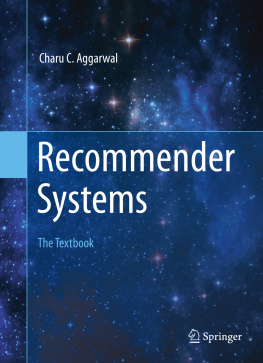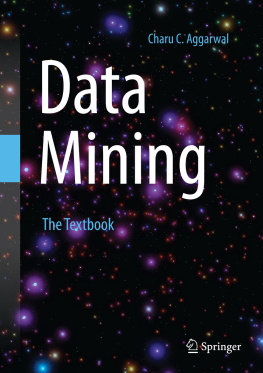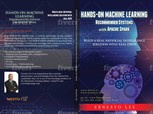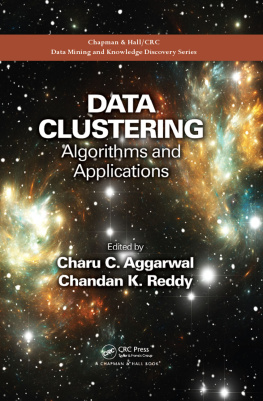Many receive advice, only the wise profit from it. Harper Lee
1.1 Introduction
The increasing importance of the Web as a medium for electronic and business transactions has served as a driving force for the development of recommender systems technology. An important catalyst in this regard is the ease with which the Web enables users to provide feedback about their likes or dislikes. For example, consider a scenario of a content provider such as Netflix. In such cases, users are able to easily provide feedback with a simple click of a mouse. A typical methodology to provide feedback is in the form of ratings , in which users select numerical values from a specific evaluation system (e.g., five-star rating system) that specify their likes and dislikes of various items.
Other forms of feedback are not quite as explicit but are even easier to collect in the Web-centric paradigm. For example, the simple act of a user buying or browsing an item may be viewed as an endorsement for that item. Such forms of feedback are commonly used by online merchants such as Amazon.com, and the collection of this type of data is completely effortless in terms of the work required of a customer. The basic idea of recommender systems is to utilize these various sources of data to infer customer interests. The entity to which the recommendation is provided is referred to as the user , and the product being recommended is also referred to as an item . Therefore, recommendation analysis is often based on the previous interaction between users and items, because past interests and proclivities are often good indicators of future choices. A notable exception is the case of knowledge-based recommender systems , in which the recommendations are suggested on the basis of user-specified requirements rather than the past history of the user.
So, what is the basic principle that underlies the working of recommendation algorithms? The basic principle of recommendations is that significant dependencies exist between user- and item-centric activity. For example, a user who is interested in a historical documentary is more likely to be interested in another historical documentary or an educational program, rather than in an action movie. In many cases, various categories of items may show significant correlations, which can be leveraged to make more accurate recommendations. Alternatively, the dependencies may be present at the finer granularity of individual items rather than categories. These dependencies can be learned in a data-driven manner from the ratings matrix, and the resulting model is used to make predictions for target users. The larger the number of rated items that are available for a user, the easier it is to make robust predictions about the future behavior of the user. Many different learning models can be used to accomplish this task. For example, the collective buying or rating behavior of various users can be leveraged to create cohorts of similar users that are interested in similar products. The interests and actions of these cohorts can be leveraged to make recommendations to individual members of these cohorts.
The aforementioned description is based on a very simple family of recommendation algorithms, referred to as neighborhood models . This family belongs to a broader class of models, referred to as collaborative filtering . The term collaborative filtering refers to the use of ratings from multiple users in a collaborative way to predict missing ratings. In practice, recommender systems can be more complex and data-rich, with a wide variety of auxiliary data types. For example, in content-based recommender systems, the content plays a primary role in the recommendation process, in which the ratings of users and the attribute descriptions of items are leveraged in order to make predictions. The basic idea is that user interests can be modeled on the basis of properties (or attributes ) of the items they have rated or accessed in the past. A different framework is that of knowledge-based systems , in which users interactively specify their interests, and the user specification is combined with domain knowledge to provide recommendations. In advanced models, contextual data, such as temporal information, external knowledge, location information, social information, or network information, may be used.
This book will study all types of basic systems, including collaborative, content-based, and knowledge-based systems. We will also discuss both the basic and the enhanced models of recommender systems in different domains. We will study various aspects of the robustness of recommender systems, such as attack models, and the construction of trustworthy models. In addition, a variety of evaluation and hybridization models for recommender systems will be studied thoroughly. In this chapter, the goal is to provide an overview of the wide diversity of work in the field of recommender systems, and also relate the various topics to the individual chapters of this book.
This chapter is organized as follows. Section discusses the conclusions and summary.
1.2 Goals of Recommender Systems
Before discussing the goals of recommender systems, we introduce the various ways in which the recommendation problem may be formulated. The two primary models are as follows:
Prediction version of problem: The first approach is to predict the rating value for a user-item combination. It is assumed that training data is available, indicating user preferences for items. For m users and n items, this corresponds to an incomplete m n matrix, where the specified (or observed ) values are used for training. The missing (or unobserved ) values are predicted using this training model. This problem is also referred to as the matrix completion problem because we have an incompletely specified matrix of values, and the remaining values are predicted by the learning algorithm.
Ranking version of problem: In practice, it is not necessary to predict the ratings of users for specific items in order to make recommendations to users. Rather, a merchant may wish to recommend the top- k items for a particular user, or determine the top- k users to target for a particular item. The determination of the top- k items is more common than the determination of top- k users, although the methods in the two cases are exactly analogous. Throughout this book, we will discuss only the determination of the top- k items, because it is the more common setting. This problem is also referred to as the top-k recommendation problem , and it is the ranking formulation of the recommendation problem.
In the second case, the absolute values of the predicted ratings are not important. The first formulation is more general, because the solutions to the second case can be derived by solving the first formulation for various user-item combinations and then ranking the predictions. However, in many cases, it is easier and more natural to design methods for solving the ranking version of the problem directly. Such methods will be discussed in Chapter
Increasing product sales is the primary goal of a recommender system. Recommender systems are, after all, utilized by merchants to increase their profit. By recommending carefully selected items to users, recommender systems bring relevant items to the attention of users. This increases the sales volume and profits for the merchant. Although the primary goal of a recommendation system is to increase revenue for the merchant, this is often achieved in ways that are less obvious than might seem at first sight. In order to achieve the broader business-centric goal of increasing revenue, the common operational and technical goals of recommender systems are as follows:













